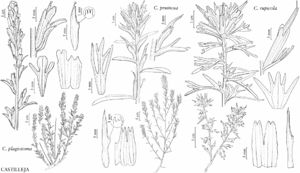Castilleja pruinosa
Erythea 6: 50. 1898. (as Castilleia)
Herbs to subshrubs, perennial, (1.2–)2–8 dm; from a woody caudex; with a taproot. Stems several to many, erect or ascending, branched or unbranched, sometimes with inconspicuous, short, leafy axillary shoots, hairs ± dense, spreading to appressed, whitish or ashy gray, long, soft, much-branched, rarely unbranched, eglandular or obscurely glandular. Leaves green, linear-lanceolate to narrowly or broadly lanceolate, 2–8 cm, not fleshy, margins plane to sometimes wavy, flat or involute, 0-lobed, sometimes 3–5-lobed distally, apex obtuse to rounded, sometimes acute; lobes sometimes divergent, ascending-spreading, linear, apex acute. Inflorescences 3–20 × 1.5–4 cm; bracts proximally greenish, distally abruptly red, sometimes yellow, salmon, or orange-red, often with a narrow yellow medial band, lanceolate, broadly lanceolate, or oblong, 0–5-lobed; lobes spreading to ascending, linear, long, arising near mid length, apex obtuse to acute. Calyces proximally green to yellow, distally and abruptly colored as in distal bracts, often with a central yellow band, 13–28 mm; abaxial clefts 5–13 mm, adaxial 8–14 mm, clefts 33–70% of calyx length, deeper than laterals, lateral 3–9 mm, 20–25% of calyx length; lobes lanceolate to triangular, apex acute to acuminate. Corollas slightly curved, 20–51 mm; tube 12–21 mm; beak long-exserted, adaxially green, yellow, or red, 12–33 mm; abaxial lip deep green, reduced, 1–2.5 mm, ca. 10% as long as beak; teeth incurved to erect, white, yellow, or green, 0.5–2 mm. 2n = 48.
Phenology: Flowering Mar–Aug.
Habitat: Dry flats, rocky slopes, talus, thickets, open forests and forest edges, usually over serpentine.
Elevation: 50–2600 m.
Distribution
Calif., Oreg.
Discussion
Castilleja pruinosa is a common and variable paintbrush at moderate elevations in the southern half of the Cascade Range, occurring westward in Oregon and in adjacent northwestern California. It is also found in the northern Sierra Nevada. The often dense pubescence of branched hairs distinguishes it from other similar species within its range. Castilleja gleasoni was sometimes included within C. pruinosa, but C. gleasoni is likely of hybrid origin and occurs only in the San Gabriel Mountains of southern California. There are significant morphological differences between C. gleasoni and C. pruinosa. Castilleja pruinosa forms occasional hybrids with C. applegatei var. pinetorum and with C. brevilobata. In some populations in Douglas and eastern Lane counties, Oregon, C. pruinosa forms introgressive swarms with C. hispida var. hispida.
Selected References
None.
